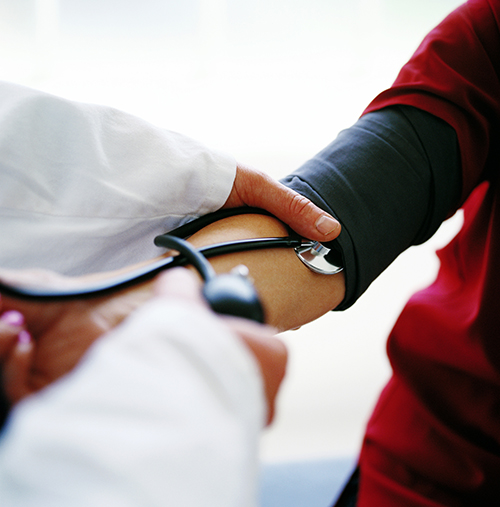|
How Can I Accurately Measure My Blood Pressure at Home From the winter 2013 issue of the Scleroderma Voice
Ask your clinician if you need a regular adult or large adult upper arm cuff, or possibly an upper arm cuff that self-adjusts to your mid-arm circumference. You will need a regular adult cuff if your mid-arm circumference is less than 13 inches (33 cm), but a large adult or self-adjusting cuff if 13-17 inches (33-43 cm). Wrist cuffs are less accurate and should be used only if mid-arm circumference is greater than 17 inches (43 cm). Purchase only electronic oscillometric devices (EODs) that have been validated for accuracy by one or more international protocols. An up-to-date listing of validated cuffs is available at www.hypertension.ca/devices-endorsed-by-hypertension-canada-dpi. If possible, purchase an EOD that stores BP measurements to bring to your clinician. EODs that automatically measure and then average three BPs at one-minute intervals may be especially convenient. Also, have your upper arm EOD confirmed for accuracy as compared to your clinician’s office aneroid or mercury device. You must prepare for a home BP measurement just as you would at an office visit.
Take your BP in the morning before breakfast and medication and again in the evening between 6 and 9 p.m. for three 3 straight days. At each measurement session, take your BP two to three times at one-minute intervals and average the results. Since readings from the first day are often higher and unstable, discard readings from the first day and average readings from the last two days.13,14 This approach to home BP measurement maximizes reproducibility and provides the best estimate of your usual or true BP. Communicate your home BP results to your clinician at an office visit or by telephone or email. Goal home BP for most patients is below 135/85 mmHg (corresponding to an office BP below 140/90 mmHg) and for patients with diabetes or chronic kidney disease, probably below 130/80 mmHg (corresponding to an office BP below 130/80 mmHg).13,15 References 1. Peters MJ, Symmons DP, McCarey D, Dijkmans BA, Nicola P, Kvien TK, et al. EULAR evidence-based recommendations for cardiovascular risk management in patients with rheumatoid arthritis and other forms of inflammatory arthritis. Ann Rheum Dis 2010;69(2):325-31. 2. Kitas GD, Gabriel SE. Cardiovascular disease in rheumatoid arthritis: state of the art and future perspectives. Ann Rheum Dis 2010;70(1):8-14. 3. Mosca M, Tani C, Aringer M, Bombardieri S, Boumpas D, Brey R, et al. European League Against Rheumatism recommendations for monitoring patients with systemic lupus erythematosus in clinical practice and in observational studies. Ann Rheum Dis 2010;69(7):1269-74. 4. Ezzati M, Lopez AD, Rodgers A, Vander Hoorn S, Murray CJ. Selected major risk factors and global and regional burden of disease. Lancet. 2002;360(9343):1347-60. 5. Panoulas VF, Toms TE, Metsios GS, Stavropoulos-Kalinoglou A, Kosovitsas A, Milionis HJ, et al. Target organ damage in patients with rheumatoid arthritis: the role of blood pressure and heart rate. Atherosclerosis 2010;209(1):255-60. 6. Khanna D, Denton CP. Evidence-based management of rapidly progressing systemic sclerosis. Best Pract Res Clin Rheumatol;24(3):387-400. 7. Myers MG, Godwin M, Dawes M, Kiss A, Tobe SW, Kaczorowski J. Measurement of blood pressure in the office: recognizing the problem and proposing the solution. Hypertension. 2010;55(2):195-200. 8. Quinn RR, Hemmelgarn BR, Padwal RS, Myers MG, Cloutier L, Bolli P, et al. The 2010 Canadian Hypertension Education Program recommendations for the management of hypertension: part I - blood pressure measurement, diagnosis and assessment of risk. Can J Cardiol. 2010;26(5):241-8. 9. Pickering TG, Hall JE, Appel LJ, Falkner BE, Graves J, Hill MN, et al. Recommendations for blood pressure measurement in humans and experimental animals: Part 1: blood pressure measurement in humans: a statement for professionals from the Subcommittee of Professional and Public Education of the American Heart Association Council on High Blood Pressure Research. Hypertension. 2005;45(1):142-61. 10. Pickering TG, Hall JE, Appel LJ, Falkner BE, Graves J, Hill MN, et al. Recommendations for blood pressure measurement in humans and experimental animals: Part 1: blood pressure measurement in humans: a statement for professionals from the Subcommittee of Professional and Public Education of the American Heart Association Council on High Blood Pressure Research. Hypertension. 2005;45(1):142-61. 11. Williams JS, Brown SM, Conlin PR. Videos in clinical medicine. Blood-pressure measurement. N Engl J Med. 2009;360(5):e6. 12. Stergiou GS, Lourida P, Tzamouranis D. Replacing the mercury manometer with an oscillometric device in a hypertension clinic: implications for clinical decision making. 2012 J Hum Hypertens Apr;26(4):220-7.. 13. Parati G, Stergiou GS, Asmar R, Bilo G, de Leeuw P, Imai Y, et al. European Society of Hypertension practice guidelines for home blood pressure monitoring. J Hum Hypertens. 2010;24(12):779-85. 14. Stergiou GS, Parati G. How to best monitor blood pressure at home? Assessing numbers and individual patients. J Hypertens. 2010;28(2):226-8. 15. Head GA, Mihailidou AS, Duggan KA, Beilin LJ, Berry N, Brown MA, et al. Definition of ambulatory blood pressure targets for diagnosis and treatment of hypertension in relation to clinic blood pressure: prospective cohort study. BMJ. 2010;340:c1104. 16. Quinn RR, Hemmelgarn BR, Padwal RS, Myers MG, Cloutier L, Bolli P, et al. The 2010 Canadian Hypertension Education Program recommendations for the management of hypertension: part I - blood pressure measurement, diagnosis and assessment of risk. Can J Cardiol;26(5):241-8. |
|
|
Back
Understanding Scleroderma
Back
Treating Scleroderma
Back
Living Well with Scleroderma
Back
Advancing Research and Treatment
Back
Get Involved



 Follow these steps to
accurately measure and monitor your blood pressure at home.7,11,13
Follow these steps to
accurately measure and monitor your blood pressure at home.7,11,13